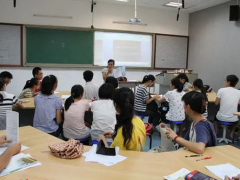英语谚语翻译理论
1.有关英语谚语翻译的论文或资料
Let me try, but I need time.ABSTRACT The development of people's ability totranslate figurative speech was studied, using sentences containing metaphors, dual function words, and proverbs, aspresented in classroom workbooks. One hundred twentychildren from first, third, fifth, and seventh grades wereasked to describe the meaning of each figurative word orphrase placed in context. Responses were scored on a fourpoint scale indicating the extent to which the child used aliteral or figurative translation. Significant effects betweengrade levels and figurative conditions were found, indicatingthat the ability to translate figurative speech proceeds alonga developmental hierarchy of language comprehension. Themajority of third grade children were able to translate metaphors and dual function words into figurative language successfully. The ability to translate proverbs required a levelof comprehension that does not appear in most childrenuntil seventh grade, as suggested by Piaget.A recent review of the psychological literature onmetaphor suggests a strong relationship betweenmetaphor comprehension and Piaget's cognitive stagesof thought development (3). Piagetian theory suggeststhat children from seven to twelve years of age developa broad range of transformational skills that allows themto operate on reality, building a repertoire of symbolsand signs (8). This display of cognitive growth representsan enormous expansion of power and abstraction in thatit frees children from the literal aspects of their perceptions.Inhelder and Piaget suggest that the capacity for poeticusage and the ability to operate on linguistic elementsmay be the last facet of language to develop (3). Theauthors' experiences in third grade classrooms, whileobserving children's understanding of figurative speechas presented in reading workbooks, revealed a wide rangeof abilities in the children's interpretation of metaphorsand proverbs at the concrete operations period of development. Some children had an immediate grasp of the multiple meanings of terms, while others, regardless of theamount of explanation given, could not override theircognitive ties to the literal interpretation.Research suggests that the capacity to understandmetaphoric speech occurs at an age beyond the preschoollevel (5). An early study investigated the development ofchildren's ability to understand dual function words,terms that have a joint reference in language to bothphysical and psychological data (1). For example, suchwords as "cold" and "warm" denote thermal propertiesand can serve a dual function in describing psychologicalaspects of people. The authors suggested that these termsare an elementary instance of metaphorical thinking andinvestigated the order in which children's understandingof dual terms emerged. Results indicated that childrenfrom three to seven are sensitive only to the literal translation, while seven- to eight-year olds demonstrate thebeginning of the ability to use the psychological sense ofthe terms. The ability to state the dual function of theterms was clearly developed in the twelve-year-old group(for example, "hard things and hard people are bothunmanageable").Further work examined the ability of preschool children to make metaphoric links, to perceive relationshipsamong disparate phenomena (6). Children, ages three tonineteen, were asked to indicate their knowledge ofliteral meanings of word pairs and then project them ontosensory domains using metaphoric skills. In contrast toearlier findings, these results indicated that the capacityfor metaphoric association between sensory modalitiesand adjectives was evident in young children.A recent investigation found a developmental trendtoward the comprehension of metaphors, though it concluded that not until the age of ten were children ableto demonstrate metaphoric understanding of dual function words (12).The ability to understand proverbs has been explainedby Piaget as part of the development of cognitive thinking (10). He proposed that children from nine to elevenyears of age use a simple projection of the proverb intosentences by process of immediate fusion. At this level,there is no analysis of detail in comprehending proverbs,but a general fusion of two propositions without analysisof their meanings. Piaget believed that this phenomenonprecedes the development of logical thinking, that theability to translate proverbs does not occur until theformal operations period.The present study examined the relationship amongmetaphors, dual function words, and proverbs, specificallylooking at 。
2.有关英语谚语翻译的论文或资料
ABSTRACT The development of people's ability totranslate figurative speech was studied, using sentences containing metaphors, dual function words, and proverbs, aspresented in classroom workbooks. One hundred twentychildren from first, third, fifth, and seventh grades wereasked to describe the meaning of each figurative word orphrase placed in context. Responses were scored on a fourpoint scale indicating the extent to which the child used aliteral or figurative translation. Significant effects betweengrade levels and figurative conditions were found, indicatingthat the ability to translate figurative speech proceeds alonga developmental hierarchy of language comprehension. Themajority of third grade children were able to translate metaphors and dual function words into figurative language successfully. The ability to translate proverbs required a levelof comprehension that does not appear in most childrenuntil seventh grade, as suggested by Piaget.A recent review of the psychological literature onmetaphor suggests a strong relationship betweenmetaphor comprehension and Piaget's cognitive stagesof thought development (3). Piagetian theory suggeststhat children from seven to twelve years of age developa broad range of transformational skills that allows themto operate on reality, building a repertoire of symbolsand signs (8). This display of cognitive growth representsan enormous expansion of power and abstraction in thatit frees children from the literal aspects of their perceptions.Inhelder and Piaget suggest that the capacity for poeticusage and the ability to operate on linguistic elementsmay be the last facet of language to develop (3). Theauthors' experiences in third grade classrooms, whileobserving children's understanding of figurative speechas presented in reading workbooks, revealed a wide rangeof abilities in the children's interpretation of metaphorsand proverbs at the concrete operations period of development. Some children had an immediate grasp of the multiple meanings of terms, while others, regardless of theamount of explanation given, could not override theircognitive ties to the literal interpretation.Research suggests that the capacity to understandmetaphoric speech occurs at an age beyond the preschoollevel (5). An early study investigated the development ofchildren's ability to understand dual function words,terms that have a joint reference in language to bothphysical and psychological data (1). For example, suchwords as "cold" and "warm" denote thermal propertiesand can serve a dual function in describing psychologicalaspects of people. The authors suggested that these termsare an elementary instance of metaphorical thinking andinvestigated the order in which children's understandingof dual terms emerged. Results indicated that childrenfrom three to seven are sensitive only to the literal translation, while seven- to eight-year olds demonstrate thebeginning of the ability to use the psychological sense ofthe terms. The ability to state the dual function of theterms was clearly developed in the twelve-year-old group(for example, "hard things and hard people are bothunmanageable").Further work examined the ability of preschool children to make metaphoric links, to perceive relationshipsamong disparate phenomena (6). Children, ages three tonineteen, were asked to indicate their knowledge ofliteral meanings of word pairs and then project them ontosensory domains using metaphoric skills. In contrast toearlier findings, these results indicated that the capacityfor metaphoric association between sensory modalitiesand adjectives was evident in young children.A recent investigation found a developmental trendtoward the comprehension of metaphors, though it concluded that not until the age of ten were children ableto demonstrate metaphoric understanding of dual function words (12).The ability to understand proverbs has been explainedby Piaget as part of the development of cognitive thinking (10). He proposed that children from nine to elevenyears of age use a simple projection of the proverb intosentences by process of immediate fusion. At this level,there is no analysis of detail in comprehending proverbs,but a general fusion of two propositions without analysisof their meanings. Piaget believed that this phenomenonprecedes the development of logical thinking, that theability to translate proverbs does not occur until theformal operations period.The present study examined the relationship amongmetaphors, dual function words, and proverbs, specificallylooking at children's ability to translate cl。
3.英语谚语带翻译
1.爱屋及乌 Love me, love my dog. 2.百闻不如一见 Seeing is believing. 3.比上不足比下有余 worse off than some, better off than many; to fall short of the best, but be better than the worst. 4.笨鸟先飞 A slow sparrow should make an early start. 5.不眠之夜 white night 6.不以物喜不以己悲 not pleased by external gains, not saddened by personnal losses 7.不遗余力 spare no effort; go all out; do one's best 8.不打不成交 No discord, no concord. 9.拆东墙补西墙 rob Peter to pay Paul 10.辞旧迎新 bid farewell to the old and usher in the new; ring out the old year and ring in the new 11.大事化小小事化了 try first to make their mistake sound less serious and then to reduce it to nothing at all 12.大开眼界 open one's eyes; broaden one's horizon; be an eye-opener 13.国泰民安 The country flourishes and people live in peace 14.过犹不及 going too far is as bad as not going far enough; beyond is as wrong as falling short; too much is as bad as too little 15.功夫不负有心人 Everything comes to him who waits. 16.好了伤疤忘了疼 once on shore, one prays no more 17.好事不出门恶事传千里 Good news never goes beyond the gate, while bad news spread far and wide. 18.和气生财 Harmony brings wealth. 19.活到老学到老 One is never too old to learn. 20.既往不咎 let bygones be bygones 21.金无足赤人无完人 Gold can't be pure and man can't be perfect. 22.金玉满堂 Treasures fill the home. 23.脚踏实地 be down-to-earth 24.脚踩两只船 sit on the fence 25.君子之交淡如水 the friendship between gentlemen is as pure as crystal; a hedge between keeps friendship green 26.老生常谈陈词滥调 cut and dried, cliché 27.礼尚往来 Courtesy calls for reciprocity. 28.留得青山在不怕没柴烧 Where there is life, there is hope. 29.马到成功 achieve immediate victory; win instant success 30.名利双收 gain in both fame and wealth 31.茅塞顿开 be suddenly enlightened 32.没有规矩不成方圆 Nothing can be accomplished without norms or standards. 33.每逢佳节倍思亲 On festive occasions more than ever one thinks of one's dear ones far away.It is on the festival occasions when one misses his dear most. 34.谋事在人成事在天 The planning lies with man, the outcome with Heaven. Man proposes, God disposes. 35.弄巧成拙 be too smart by half; Cunning outwits itself 36.拿手好戏 masterpiece 37.赔了夫人又折兵 throw good money after bad 38.抛砖引玉 a modest spur to induce others to come forward with valuable contributions; throw a sprat to catch a whale 39.破釜沉舟 cut off all means of retreat;burn one's own way of retreat and be determined to fight to the end 40.抢得先机 take the preemptive opportunities 41.巧妇难为无米之炊 If you have no hand you can't make a fist. One can't make bricks without straw. 42.千里之行始于足下 a thousand-li journey begins with the first step--the highest eminence is to be gained step by step 43.前事不忘后事之师 Past experience, if not forgotten, is a guide for the future. 44.前人栽树后人乘凉 One generation plants the trees in whose shade another generation rests.One sows and another reaps. 45.前怕狼后怕虎 fear the wolf in front and the tiger behind hesitate in doing something 46.强龙难压地头蛇 Even a dragon (from the outside) finds it hard to control a snake in its old haunt - Powerful outsiders can hardly afford to neglect local bullies. 47.强强联手 win-win co-operation 48.瑞雪兆丰年 A timely snow promises a good harvest. 49.人之初性本善 Man's nature at birth is good. 50.人逢喜事精神爽 Joy puts heart into a man. 51.人海战术 huge-crowd strategy 52.世上无难事只要肯攀登 Where there is a will, there is a way. 53.世外桃源 a fictitious land of peace away from the turmoil of the world; 54.死而后已 until my heart stops beating 55.岁岁平安 Peace all year round. 56.上有天堂下有苏杭 Just as there is paradise in heaven, ther are Suzhou and Hangzhou on earth 57.塞翁失马焉知非福 Misfortune may be an actual blessing. 58.三十而立 A man should be independent at the age of thirty.At thirty, a man should be able to think for himself. 59.升级换代 updating and upgrading (of products) 60.四十不惑 Life begins at forty. 61.谁言寸草心报得三春晖 Such kindness of warm sun, can't be repaid by grass. 62.水涨船高 When the river rises, the boat floats high. 63.时不我待Time and tide wait for no man. 64.杀鸡用牛刀break a butterfly on the wheel 65.实事求是seek truth from facts; be practical and realistic; be true to facts 66.说曹操,曹操到Talk of the devil and he comes. 67.实话实说speak the plain truth; call a spade a spade; tell it as it is 68.实践是检验真理的唯一标准Practice is the sole criterion for testing truth. 69.山不在高,有仙则名'No matter how high the mountain is, its 。
4.英语谚语的翻译
. Like bamboo shoots after a spring shower.雨后春笋 2.To go through fire and water.赴汤蹈火 3.To apprehend danger in every sound.草木皆兵 4.It's never too late to learn.学无止境,活到老学到老 5. Remember the past and it will guide your future.温故知新 6.A single spark can start a prairie fire.星星之火,可以燎原毛遂自荐 to volunteer one's service (毛遂——战国时期人名) 初出茅庐 at the beginning of one's career (出自《三国演义》的典故) 东施效颦 crude imitation with ludicrous effect (东施——古代一丑女的名字) 南柯一梦 a fond dream or illusory joy (南柯——古代传说的梦中地名) 四面楚歌 to be besieged on all sides (楚——战国时期的地名)1.World is but a little place, after all. 天涯原咫尺,到处可逢君 Explanation: it is used when a person meets someone he knows or is in someway connected with him in a place where he would never have expected to do so. Example: Who would have thought I would bump into an old schoolmate on a trek up Mount Tai.The world is but a little place after all. 2. When in Rome, do as the Romans do. 入乡随俗 Explanation: conform to the manners and customs of those amongst whom you live. Example: I know you have egg and bacon for breakfast at home, but now you are on the Continentyou will do as the Romans do and take coffee and rolls. 3. What you lose on the swings you get back on the roundabouts. 失之东隅,收之桑榆 Explanation: a rough way of starting a law of average; if you have bad luck on one day you havegood on another; if one venture results in loss try a fresh one---it may succeed. Example: he may always possess merits which make up for everything; if he loses on the swings, he may win on the roundabouts. 4.What are the odds so long as you are happy. 知足者常乐 Explanation: what does anything else matter if a person is happy. Example: you complain so much, but you have a good family, parents, health, and money. What's the odd so long as you're happy. 5.Entertain an angel unawares. 有眼不识泰山 Explanation: to receive a great personage as a guest without knowing his merits. Example: in the course of evening someone informed her that she was entertaining an angel unawares, in the shape of a composer of the greatest promise 6.every dog has his day . 是人皆有出头日 Explanation: fortune comes to each in turn Example: they say that every dog has his day; but mine seems a very long time coming. 7.every potter praises his own pot. 王婆买瓜,自卖自夸 Explanation: people are loath to refer to defects in their possessions or their family members Example: he said that his teacher considered his work brilliant, but I would rather hear it from his teacher's own mouth. Every potter praises his own pot 成语翻译(二) 1. Pain past is pleasure. (过去的痛苦就是快乐。)
[无论多么艰难一定要咬牙冲过去,将来回忆起来一定甜蜜无比。] 2. While there is life, there is hope. (有生命就有希望/留得青山在,不怕没柴烧。)
3. Wisdom in the mind is better than money in the hand. (脑中有知识,胜过手中有金钱。)[从小灌输给孩子的坚定信念。
] 4. Storms make trees take deeper roots. (风暴使树木深深扎根。)[感激敌人,感激挫折!] 5. Nothing is impossible for a willing heart. (心之所愿,无所不成。)
[坚持一个简单的信念就一定会成功。] 6. The shortest answer is doing. (最简单的回答就是干。)
[想说流利的英语吗?那么现在就开口!心动不如嘴动。] 7. All things are difficult before they are easy. (凡事必先难后易。)
[放弃投机取巧的幻想。] 8. Great hopes make great man. (伟大的理想造就伟大的人。)
9. God helps those who help themselves.(天助自助者。) 10. Four short words sum up what has lifted most successful individuals above the crowd: a little bit more. (四个简短的词汇概括了成功的秘诀:多一点点!) [比别人多一点努力、多一点自律、多一点决心、多一点反省、多一点学习、多一点实践、多一点疯狂,多一点点就能创造奇迹!] 11. In doing we learn.(实践长才干。)
12. East or west, home is best.(东好西好,还是家里最好。) 13. Two heads are better than one.(三个臭皮匠,顶个诸葛亮。)
14. Good company on the road is the shortest cut.(行路有良伴就是捷径。) 15. Constant dropping wears the stone.(滴水穿石。)
16. Misfortunes never come alone/single.(祸不单行。) 17. Misfortunes tell us what fortune is.(不经灾祸不知福。)
18. Better late than never.(迟做总比不做好;晚来总比不来好。) 19. It's never too late to mend.(过而能改,善莫大焉;亡羊补牢,犹未晚也。)
20. If a thing is worth doing it is worth doing well.(如果事情值得做,就值得做好。) 21. Nothing great was ever achieved without enthusiasm.(无热情。
5.英语谚语翻译
1 Don't look forward to the day you stop suffering, because when it comes you know you'll be dead. 生于忧患,死于安乐.
2 A dog starving at his master's gate predicts the ruin of the state. 树死先从叶子黄.
3 I would rather have a mind opened by wonder than one closed by custom. 宁愿创新,不愿陈腐.
4 Gather you rosebuds while you may, old time is still a flying, and this same flower that smiles today,tomorrow will be dying. 未雨绸缪.
5 However big the fool, there is always a bigger fool to admire him. 傻瓜总会发现有比他更傻的人在赞美他.
6 Belief, then, is the great guide of human life. 信仰是生活的向导.
7 Other people's harvests are always the best harvests, but one's own children are always the best children. 别人的成就/收获怎么看都比自己的好,而自己的孩子怎么看都比别人的孩子好.
8 There is no feast on earth that does not end in parting. 天下没有不散的宴席.
9 Everyone has some tricks they can do, but each has his own way of doing them. 八仙过海,各显神通.
10 Those who can lose shall gain; those who wish for gain shall lose. 有意栽花花不开,无心插柳柳成荫./阴差阳错.
6.英语的谚语带翻译
Better late than never. 亡羊补牢犹未晚也
Better to be alone than in bad company. 与其交坏朋友不如没有朋友。
Between two tools you fall to the ground. 脚踏双凳必坠地。
A bird in hand is worth two in the bush. 一鸟在手胜于两鸟在林。
Birds of a feather flock together. 物以类聚。
Birth is much, but breeding is more. 教养重于家世。
The biter is sometimes bit. 欺人反受欺,害人反害己。
Blessed is he who expressed nothing, for he shall never be disappointed. 无奢者得福,因为他永无失望之时。
Blood is thicker than water. 血浓于水。
Books and friends should be few and good. 书与友贵精而不贵多。
Books are by far the most lasting products of human effort. 书籍乃是人类努力成果中最能历久弥新的产物。
A burnt child dreads the fire. 受灼的小孩必怕火。
The business of life is to go-forward. 生命的要务是奋力向前
7.奈达功能对等理论四个方面(词汇对等、句法对等、篇章对等、文体对
出处: Toward a Science of Translating 《翻译的科学探索》在Principles of correspondence 那一章
定义:翻译时不求文字表面的死板对应,而要在两种语言间达成功能上的对等。
奈达是美国人,师从几位著名的结构主义语言大师,本身也是有重要地位的语言学家,曾任美国语言学会主席。但这位在学术界赫赫有名的人物,偏偏远离学术重镇,默默地在美国圣经协会供职半个多世纪。他一生的主要学术活动都围绕《圣经》翻译展开。在《圣经》翻译的过程中,奈达从实际出发,发展出了一套自己的翻译理论,最终成为翻译研究的经典之一。奈达理论的核心概念是“功能对等”。所谓“功能对等”,就是说翻译时不求文字表面的死板对应,而要在两种语言间达成功能上的对等。
为使源语和目的语的之间的转换有一个标准,减少差异,尤金·A·奈达从语言学的角度出发,根据翻译的本质,提出了著名的“动态对等”翻译理论,即“功能对等”。在这一理论中,他指出“翻译是用最恰当、自然和对等的语言从语义到文体再现源语的信息”(郭建中,2000 , P65) 。奈达有关翻译的定义指明翻译不仅是词汇意义上的对等还包括语义、风格和文体的对等,翻译传达的信息既有表层词汇信息也有深层的文化信息。“动态对等”中的对等包括四个方面:1. 词汇对等,2. 句法对等,3. 篇章对等,4. 文体对等。在这四个方面中,奈达认为“意义是最重要的,形式其次”(郭建中,2000 , P67) 。形式很可能掩藏源语的文化意义并阻碍文化交流。因此,在文学翻译中,根据奈达的理论,译者应以动态对等的四个方面作为翻译的原则准确地在目的语中再现源语的文化内涵。
为了准确地再现源语文化和消除文化差异,译者可以遵循以下的三个步骤。第一,努力创造出既符合原文语义又体现原文文化特色的译作。然而,两种语言代表着两种完全不同的文化,文化可能有类似的因素,但不可能完全相同。因此,完全展现原文文化内涵的完美的翻译作品是不可能存在的,译者只能最大限度地再现源语文化。第二,如果意义和文化不能同时兼顾,译者只有舍弃形式对等,通过在译文中改变原文的形式达到再现原文语义和文化的目的。例如,英语谚语“white as snow”翻译成汉语可以是字面意义上的“白如雪”。但是,中国南方几乎全年无雪,在他们的文化背景知识中,没有“雪”的概念,如何理解雪的内涵? 在译文中,译者可以通过改变词汇的形式来消除文化上的差异。因此,这个谚语在汉语中可以译作“白如蘑菇”,“白如白鹭毛”(郭建中,2000 ,P63) 。再如,英语成语“spring uplike mushroom”中“mushroom”原意为“蘑菇”, 但译为汉语多为“雨后春笋”,而不是“雨后蘑菇”,因为在中国文化中,人们更为熟悉的成语和理解的意象是“雨后春笋”。第三,如果形式的改变仍然不足以表达原文的语义和文化,可以采用“重创”这一翻译技巧来解决文化差异,使源语和目的语达到意义上的对等。“重创”是指将源语的深层结构转换成目的语的表层结构(郭建中,2000 , P67) ,也就是将源语文章的文化内涵用译语的词汇来阐述和说明。在此句的英文原文中,原文的内涵并不是靠词汇的表面意义表达出来的,而是隐藏在字里行间里。
因此,如按照英汉两种语言字面上的对等来翻译,原句译为“他靠传染来思维,象感冒一样获得思想”,这样,原文的真正意义就无法清楚地表达。事实上,在汉语中很难找到一个完全与英文对等的句型来表达同样的内涵。于是,译者将源语的深层结构转换成目的语的表层结构,即用目的语中相应的词汇直接说明、解释原文的内涵,以使译文读者更易接受译作。
根据奈达的翻译理论,文化差异的处理是与从语义到文体将源语再现于目的语紧密相联的。只有当译文从语言形式到文化内涵都再现了源语的风格和精神时,译作才能被称作是优秀的作品。







